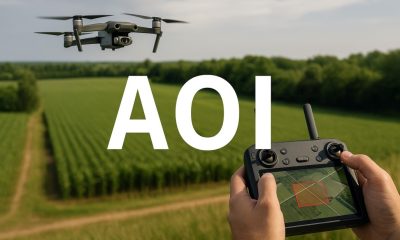German Drone Regulations
German Drone Operating Rules
Published
8 months agoon
Table Of Contents

German Drone Operating Rules – What Are They?
Navigating the German Drone Operating Rules is essential for anyone flying drones in Germany, whether for recreational or commercial purposes. These regulations cover a wide range of requirements, including where and how high drones can fly, the conditions for obtaining necessary permits, and safety protocols that ensure responsible drone usage. Understanding these rules not only helps operators comply with legal standards but also promotes safe and respectful use of airspace.
Maximum Altitude
120 Meter Height Restriction
- Altitude Limit: Drones must not be flown higher than 120 meters (400 feet) above ground level without special permission. This limit ensures that drones do not interfere with manned aircraft, which typically operate at higher altitudes.
- Exemptions: In certain cases, operators may apply for special permissions from the LBA to fly at altitudes exceeding 120 meters. This is often necessary for operations such as large-scale surveying, inspections of tall structures, or specific commercial applications.
Visual Line of Sight (VLOS)
Maintaining Visual Contact
- VLOS Rule: Drone operators must maintain visual line of sight (VLOS) with their drone at all times during flight. This means the drone must remain visible to the operator without the aid of binoculars or other visual devices.
- Spotters for Assistance: In some cases, operators may use spotters to assist with maintaining visual contact, especially in complex environments. Spotters can help ensure that the drone remains in line of sight while the operator focuses on controlling the drone.
Restricted Airspace
No-Fly Zones
- Airports and Controlled Airspace: Drones are prohibited from flying within 1.5 kilometers of airports or aerodromes unless special permission is granted. This rule is in place to prevent collisions with manned aircraft. Operators must check with Deutsche Flugsicherung (DFS), Germany’s air traffic control agency, for real-time airspace information before flying.
- Military Zones and Government Buildings: Flying near military installations, government buildings, and other sensitive infrastructure is strictly prohibited without prior authorization. This helps protect national security and prevent potential safety risks.
- Nature Reserves: Drones are not allowed to operate over nature reserves or protected areas without special permission from environmental authorities. This restriction helps protect wildlife and sensitive ecosystems from disruption.
Geofencing
- Built-In Technology: Many modern drones are equipped with geofencing technology that automatically prevents them from entering restricted airspace, such as around airports or military zones. Operators should ensure that this feature is activated and up to date to avoid accidental violations.
Distance from People and Property
Minimum Distances
- People and Property: Operators must maintain a safe distance from people, vehicles, and buildings that are not involved in the drone operation. Generally, a minimum distance of 50 meters must be kept between the drone and any uninvolved persons or property.
- Crowded Areas: Flying over crowds or large gatherings, such as concerts, festivals, or public events, is strictly prohibited without special permission. This rule minimizes the risk of injury in case of a malfunction or loss of control.
Night Operations
Rules for Flying at Night
- Lighting Requirements: Drones flown at night must be equipped with anti-collision lights visible from at least 3 nautical miles. These lights help increase the visibility of the drone to other airspace users and the operator.
- Special Permissions: Night flights are considered higher-risk operations and require special permission from the LBA. Operators must demonstrate that they have the necessary skills, equipment, and safety protocols in place to manage the risks associated with flying in low-light conditions.
Weather Conditions
Flying in Adverse Weather
- Weather Restrictions: Drone operations should not be conducted in adverse weather conditions, such as heavy rain, high winds, fog, or thunderstorms. These conditions can affect the drone’s stability and the operator’s ability to maintain control.
- Pre-Flight Weather Checks: Operators should always check weather forecasts before flights to ensure that conditions are safe for drone operations. Flying in poor weather increases the risk of accidents and may lead to legal penalties if it results in a safety violation.
Emergency Procedures
Handling Emergencies
- Lost Link Protocols: If the connection between the drone and its controller is lost, the drone’s automatic Return-to-Home (RTH) function should be activated. This feature guides the drone back to its takeoff point safely.
- Battery Management: Operators must monitor the drone’s battery levels closely during flight. The drone should be landed before the battery runs too low to prevent loss of power mid-flight.
Insurance
Liability Insurance Requirements
- Mandatory Insurance: All drone operators, whether flying recreationally or commercially, must carry liability insurance. This insurance covers potential damages or injuries caused by the drone during its operation. The insurance policy must meet the minimum requirements set by German law.
Summary
By adhering to the German Drone Operating Rules, drone pilots contribute to a safer and more organized airspace. Compliance with these regulations ensures that drones are used responsibly and harmoniously alongside manned aircraft, protecting public safety and fostering a positive environment for technological innovation. Following these rules is crucial for operating drones legally and effectively within Germany.
To Learn more about acronyms used in this article visit our Drones Acronym Page.











